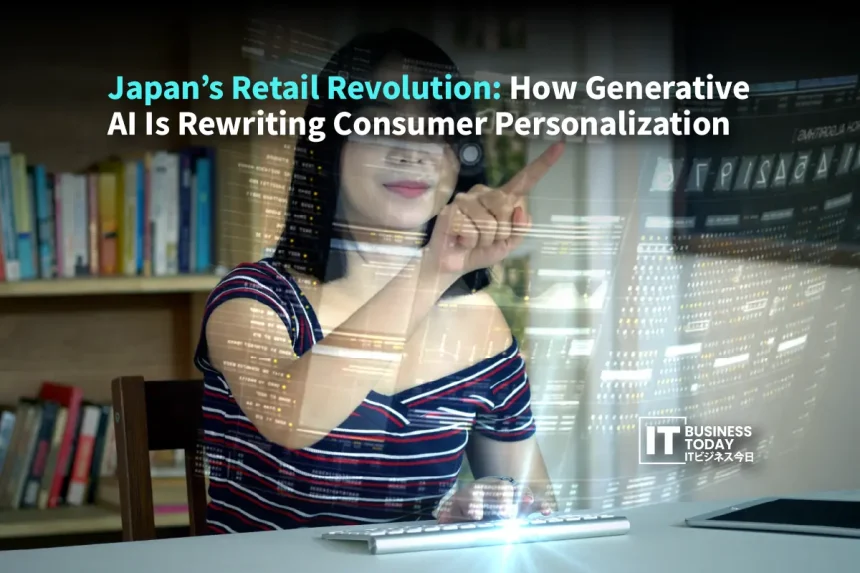日本のサービス文化は世界的に有名になりました。おもてなしと呼ばれる伝統は高い基準を設定しており、現代のペースの速いデジタルの世界でさえ、このような高い基準を維持するのは本当に難しいことです。オンラインショッピングの利用者は、迅速なサービス、利便性、パーソナルな体験を求めます。
日本では、消費者のパーソナライゼーションは単なる流行語ではありません。それは、毎回、細部まで正しく伝えることを意味します。一般的な推薦や間違いは、すぐに信頼を失います。顧客はオファーの不注意に気づくため、正確さと文脈が不可欠なのです。
この変化の主な理由は、ジェネレーティブAIの開発です。AIは、大まかなセグメントやルールベースのアプローチではなく、個人の嗜好に応じてインタラクションを変化させることができます。それは、AIを通じて「おもてなし」のコンセプトを最大限に活用するデジタル・ショッパーのようなものです。このように、小売業者は効率的で人間らしいカスタマーサポートを提供することができます。
こちらもお読みください: ITオペレーションにおけるAI:エンタープライズオートメーションの次のステップ
日本の小売業界を取り巻く独自の圧力
日本の小売業界は、静かに、しかし容赦ないプレッシャーにさらされています。高齢化と労働人口の減少は、もはやゆっくりとしたトレンドではなく、積極的な制約となっています。店舗は、顧客が期待するような温かさと正確さを提供するのに十分な人員を確保することができません。そのため、小売企業は効率化だけでなく、生き残りをかけた自動化を余儀なくされているのです。真の試練はコスト削減ではありません。サービスの質を維持することです。
そして、ここに文化的なパラドックスがあります。日本の店内サービスは常に大国です。お辞儀のひとつひとつ、きちんと梱包された袋、小さなしぐさのひとつひとつが、日本の有名な「おもてなし」の精神につながっているのです。しかし、オンラインでは、そのような気配りがしばしば崩れてしまいます。デジタル・エクスペリエンスは、顧客をセグメントに分類し、そのセグメントを「顧客」と呼ぶ、時代遅れのルールベースのシステムに依存しています。 パーソナル化.その結果、冷たく、一般的で、買い物客が慣れ親しんでいる店舗カウンターの温かさとはまったく違うものに感じられます。
これこそが、ジェネレーティブAIが解決しようとしていることなのです。平均値に基づいて予測する旧式の機械学習とは異なり、GenAIは文脈を学習します。GenAIは、顧客が何をクリックしたかだけでなく、何を意味しているかを理解します。会話を行い、口調を調整し、実際にパーソナルに感じられる体験を作り出すことができます。富士通の最新のリテールAIツールは、このシフトが実際にどのように見えるかを示しています。そのインテリジェントなバーチャル・アシスタントは、デジタル・ショッピングをよりスムーズにし、AIを搭載したコンピュータ・ビジョンは、微妙なレジの不正を、それが損失になる前に発見します。これらの進歩は、消費者のパーソナライゼーションにおける新たな段階を示すものであり、テクノロジーが人的サービスに取って代わるのではなく、デジタルの世界に向けてその精神をスケールアップさせるものです。
GenAIが現代小売業のパーソナルエージェントになるまで
GenAIは、日本の小売業の次なるイノベーションを支える静かなパワーハウスとなりつつあります。GenAIは買い物客の行動を分析するだけでなく、なぜそうするのかを学習します。大規模言語モデルは現在、天候データや地域イベントから閲覧行動や購入履歴まで、あらゆるものを処理します。ベテランの販売員がボディランゲージを読み取るように、文脈を読み取ります。その結果、自動化されたものではなく、直感的に感じられるコンテンツが生まれます。ブランドは、幅広いオファーを発信する代わりに、リアルタイムで顧客の意図に合わせて変化するコンテキストを認識した体験を提供することができます。
これはすでに大規模に起こっています。 楽天の2025年 楽天AIの展開はターニングポイントです。このジェネレーティブAIサービスは、楽天のエコシステム全体のあらゆるデジタル・インタラクションをパーソナライズするように設計されており、間もなく楽天市場でライブ配信される予定です。その関連プラットフォームであるRakuten AI for Businessは、マーケティング担当者がキャンペーンのコピー、広告のバリエーション、ランディングページを数秒で生成できるよう支援します。これまでクリエイティブチームが数週間かかっていた作業が一瞬で完了し、トーンも手作り感があります。
同じエンジンが、ジェネレーティブ・マーチャンダイジングとして知られるものを動かします。GenAIは、デザインサイクルを待つ代わりに、トレンドレポートをローカライズされた商品モックアップに変換し、生産することができます。この俊敏性により、市場投入までの時間が短縮され、小売業者は移り変わる顧客の嗜好に即座に対応できるようになります。
次に会話レイヤーの登場です。チャットボットや音声アシスタントはもはや カスタマーサポート ツール。気分や好み、文脈を理解するデジタル仲間として機能します。人間のコンサルタントのように、商品を勧め、機能を比較し、スタイリングを提案します。これは、日本における消費者パーソナライゼーションの新しい顔であり、より早く顧客にサービスを提供するだけでなく、よりよく聞き、より早く学び、常に適応するテクノロジーです。それは、ついにコードに翻訳された「おもてなし」のデジタルな生まれ変わりなのです。
日本の小売業における実例とケーススタディ

日本の小売業の変革は、もはや机上の空論ではありません。それは通路や倉庫、そしてコンビニのカウンターの向こう側でさえ起こっているのです。日本で最も信頼できる日常生活のシンボルであるコンビニエンスストアは今、予測インテリジェンスによって静かに動いています。 ジェネアイ のモデルは、リアルタイムのデータを活用して、天候や湿度、地域のイベントなどを含むミクロレベルの需要を予測しています。新宿駅に隣接する店舗では、雨の日に野球の試合直前に消費される弁当や飲み物の数を正確に予測することができます。このような精度は無駄を省き、売上を増やし、棚を都市生活のペースと完全に同期させることを可能にします。
同じインテリジェンスが、日本のファストファッションシーンを再構築しています。小売業者はGenAIを利用して、環境に合わせて地域限定の商品を提案しています。天気予報が変わった瞬間に、アプリが「通勤用の雨に強いヒートテック服」を提案するのを想像してみてください。これは、文化的なニュアンスと、形と同じくらい機能を重視する日本の消費者の実用的な考え方を尊重したパーソナライゼーションです。
実店舗では、「おもてなし」がデジタルの味方になっています。AIコパイロットは、顧客のインサイト、過去の購入履歴、嗜好、閲覧履歴までをリアルタイムで表示するタブレットを従業員に装備。スタッフは、標準的なスクリプトの代わりにパーソナライズされた提案で再来店の買い物客を迎えることができます。
一方、オンライン上の棚は、もはやキーワードの静的なグリッドではありません。ジェネレーティブAIにより、サイト検索は個人の行動から学習します。意図を修正し、曖昧なフレーズを解釈し、入力された言葉だけでなく、雰囲気や文脈に合った商品を表示します。
ソフトバンク は、このインフラシフトの多くを推進しています。2025年、ソフトバンクは「Cristal Intelligence」構想を明らかにし、日本最先端のAI計算プラットフォームを構築。また、日本マイクロソフトとの提携により、ソフトバンクは生成的AIによるコールセンター業務の最適化を開始し、カスタマーサポートを台本通りのやり取りではなく、パーソナライズされた体験に変えました。これらの取り組みにより、小売エコシステムは、かつては不可能と考えられていた、顧客の声に耳を傾け、予測し、正確なサービスを提供できるようになりました。
AIにおける信頼経済と倫理
日本では、信頼が小売の基本です。消費者のパーソナライゼーションは顧客から求められていますが、同時に、顧客は自分たちの商品を プライバシー 保護されるべきです。PIPAのような規制は、データが非常に透明で安全な方法で処理されることを明確にしています。注意を払わずにパーソナライズを優先する小売業者は、顧客を遠ざけてしまうでしょう。
難しいのは、AIを人間に見せることです。提案は、あなたの好き嫌いを熟知した店員が親切にヒントを与えてくれるようなものであるべきで、あなたの次の行動を推測しようとするロボットのようなものであってはなりません。消費者パーソナライゼーションが適切に行われれば、目に見えない「おもてなし」の心遣いを示すことができます。
信頼性も同様に重要です。日本の小売企業は、常に正確な結果を提供するツールを求めています。誤った提案や欠陥のある予測は、顧客の信頼を損ない、ブランドの評判を傷つける可能性があります。
透明性があれば完璧です。AIシステムは、推奨を行った理由を説明できなければなりません。ソニーはAI倫理ガイドラインで強力な模範を示しており、従業員が責任を持ってAIを扱い、意思決定を追跡して理解できるようにしています。ソニーのロボット工学への取り組みは エイトリオス プラットフォームは、倫理とオートメーションが実用的な方法で共存できることを示しています。
結局のところ、日本の小売業が示しているのは、消費者のパーソナライゼーションは信頼を得てこそ成り立つということです。パーソナライゼーション、プライバシー、そして透明性が一体となったとき、テクノロジーはより速く顧客にサービスを提供するだけでなく、よりスマートに、そして人間的なタッチを反映するような気遣いをもって顧客にサービスを提供することができるのです。
グローバル・ラボとしての日本

伝統とテクノロジーの融合を世界に示す日本。ジェネレーティブAIはもはや単なる効率化のためのツールではありません。おもてなしの心」と「デジタル・リテールのスピード」をつなぐ架け橋となっています。店舗は、日本のサービスの特徴である人間味を失うことなく、パーソナルで、タイムリーで、心のこもった体験を提供できるようになりました。
これからの日本は AI しかし、他国が追随できないレベルでテストを行っています。品質、倫理、配慮に対する文化的な期待が、小売業者に責任を持ってAIを導入するよう促しています。そのため、この国は信頼できるパーソナライゼーションの世界的な実験場となっています。
教訓はシンプルです。小売業の革命は、派手な技術や取引の高速化ではありません。真のブレークスルーは、AIがヒューマン・サービスの原則を反映したときに起こります。日本では、最良の消費者パーソナライゼーションとは、気配り、正確さ、尊敬の念をデジタルで表現することです。







